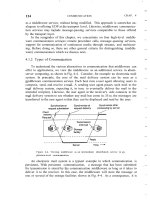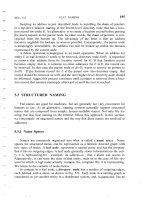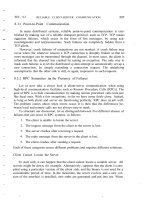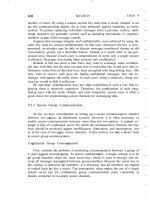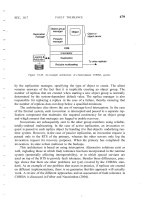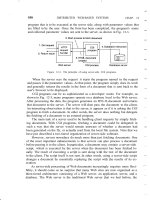distributed systems concepts and design 5th edition
Bạn đang xem bản rút gọn của tài liệu. Xem và tải ngay bản đầy đủ của tài liệu tại đây (9.7 MB, 1,067 trang )
This page intentionally left blank
DISTRIBUTED SYSTEMS
Concepts and Design
Fifth Edition
This page intentionally left blank
DISTRIBUTED SYSTEMS
Concepts and Design
Fifth Edition
George Coulouris
Cambridge University
Jean Dollimore
formerly of Queen Mary,
University of London
Tim Kindberg
matter 2 media
Gordon Blair
Lancaster University
Editorial Director: Marcia Horton
Editor-in-Chief: Michael Hirsch
Executive Editor: Matt Goldstein
Editorial Assistant: Chelsea Bell
Vice President, Marketing: Patrice Jones
Marketing Manager: Yezan Alayan
Marketing Coordinator: Kathryn Ferranti
Vice President, Production: Vince O’Brien
Managing Editor: Jeff Holcomb
Senior Production Project Manager: Marilyn Lloyd
Senior Operations Supervisor: Alan Fischer
Manufacturing Buyer: Lisa McDowell
Art Director: Jayne Conte
Cover Designer: Suzanne Duda
Cover Image: Sky: © amygdala_imagery; Kite: © Alamy;
Mobile phone: © yasinguneysu/iStock
Media Editor: Daniel Sandin
Media Project Manager: Wanda Rockwell
Printer/Binder: Edwards Brothers
Cover Printer: Lehigh-Phoenix Color
Typesetting and layout by the authors using FrameMaker
ISBN 10: 0-13-214301-1
ISBN 13: 978-0-13-214301-1
Copyright © 2012, 2005, 2001, 1994, 1988 Pearson Education, Inc., publishing as Addison-Wesley. All
rights reserved. Manufactured in the United States of America. This publication is protected by Copyright,
and permission should be obtained from the publisher prior to any prohibited reproduction, storage in a
retrieval system, or transmission in any form or by any means, electronic, mechanical, photocopying,
recording, or likewise. To obtain permission(s) to use material from this work, please submit a written
request to Pearson Education, Inc., Permissions Department, 501 Boylston Street, Suite 900, Boston,
Massachusetts 02116.
Many of the designations by manufacturers and sellers to distinguish their products are claimed as trade-
marks. Where those designations appear in this book, and the publisher was aware of a trademark claim,
the designations have been printed in initial caps or all caps.
Library of Congress Cataloging-in-Publication Data available upon request
Impression 1
10 9 8 7 6 5 4 3 2 1—EB—15 14 13 12 11
V
CONTENTS
PREFACE XI
1 CHARACTERIZATION OF DISTRIBUTED SYSTEMS 1
1.1 Introduction 2
1.2 Examples of distributed systems 3
1.3 Trends in distributed systems 8
1.4 Focus on resource sharing 14
1.5 Challenges 16
1.6 Case study: The World Wide Web 26
1.7 Summary 33
2 SYSTEM MODELS 37
2.1 Introduction 38
2.2 Physical models 39
2.3 Architectural models 40
2.4 Fundamental models 61
2.5 Summary 76
3 NETWORKING AND INTERNETWORKING 81
3.1 Introduction 82
3.2 Types of network 86
3.3 Network principles 89
3.4 Internet protocols 106
3.5 Case studies: Ethernet, WiFi and Bluetooth 128
3.6 Summary 141
VI CONTENTS
4 INTERPROCESS COMMUNICATION 145
4.1 Introduction 146
4.2 The API for the Internet protocols 147
4.3 External data representation and marshalling 158
4.4 Multicast communication 169
4.5 Network virtualization: Overlay networks 174
4.6 Case study: MPI 178
4.7 Summary 181
5 REMOTE INVOCATION 185
5.1 Introduction 186
5.2 Request-reply protocols 187
5.3 Remote procedure call 195
5.4 Remote method invocation 204
5.5 Case study: Java RMI 217
5.6 Summary 225
6 INDIRECT COMMUNICATION 229
6.1 Introduction 230
6.2 Group communication 232
6.3 Publish-subscribe systems 242
6.4 Message queues 254
6.5 Shared memory approaches 262
6.6 Summary 274
7 OPERATING SYSTEM SUPPORT 279
7.1 Introduction 280
7.2 The operating system layer 281
7.3 Protection 284
7.4 Processes and threads 286
7.5 Communication and invocation 303
7.6 Operating system architecture 314
7.7 Virtualization at the operating system level 318
7.8 Summary 331
CONTENTS VII
8 DISTRIBUTED OBJECTS AND COMPONENTS 335
8.1 Introduction 336
8.2 Distributed objects 337
8.3 Case study: CORBA 340
8.4 From objects to components 358
8.5 Case studies: Enterprise JavaBeans and Fractal 364
8.6 Summary 378
9 WEB SERVICES 381
9.1 Introduction 382
9.2 Web services 384
9.3 Service descriptions and IDL for web services 400
9.4 A directory service for use with web services 404
9.5 XML security 406
9.6 Coordination of web services 411
9.7 Applications of web services 413
9.8 Summary 419
10 PEER-TO-PEER SYSTEMS 423
10.1 Introduction 424
10.2 Napster and its legacy 428
10.3 Peer-to-peer middleware 430
10.4 Routing overlays 433
10.5 Overlay case studies: Pastry, Tapestry 436
10.6 Application case studies: Squirrel, OceanStore, Ivy 449
10.7 Summary 458
11 SECURITY 463
11.1 Introduction 464
11.2 Overview of security techniques 472
11.3 Cryptographic algorithms 484
11.4 Digital signatures 493
11.5 Cryptography pragmatics 500
11.6 Case studies: Needham–Schroeder, Kerberos, TLS, 802.11 WiFi 503
11.7 Summary 518
VIII CONTENTS
12 DISTRIBUTED FILE SYSTEMS 521
12.1 Introduction 522
12.2 File service architecture 530
12.3 Case study: Sun Network File System 536
12.4 Case study: The Andrew File System 548
12.5 Enhancements and further developments 557
12.6 Summary 563
13 NAME SERVICES 565
13.1 Introduction 566
13.2 Name services and the Domain Name System 569
13.3 Directory services 584
13.4 Case study: The Global Name Service 585
13.5 Case study: The X.500 Directory Service 588
13.6 Summary 592
14 TIME AND GLOBAL STATES 595
14.1 Introduction 596
14.2 Clocks, events and process states 597
14.3 Synchronizing physical clocks 599
14.4 Logical time and logical clocks 607
14.5 Global states 610
14.6 Distributed debugging 619
14.7 Summary 626
15 COORDINATION AND AGREEMENT 629
15.1 Introduction 630
15.2 Distributed mutual exclusion 633
15.3 Elections 641
15.4 Coordination and agreement in group communication 646
15.5 Consensus and related problems 659
15.6 Summary 671
CONTENTS IX
16 TRANSACTIONS AND CONCURRENCY CONTROL 675
16.1 Introduction 676
16.2 Transactions 679
16.3 Nested transactions 690
16.4 Locks 692
16.5 Optimistic concurrency control 707
16.6 Timestamp ordering 711
16.7 Comparison of methods for concurrency control 718
16.8 Summary 720
17 DISTRIBUTED TRANSACTIONS 727
17.1 Introduction 728
17.2 Flat and nested distributed transactions 728
17.3 Atomic commit protocols 731
17.4 Concurrency control in distributed transactions 740
17.5 Distributed deadlocks 743
17.6 Transaction recovery 751
17.7 Summary 761
18 REPLICATION 765
18.1 Introduction 766
18.2 System model and the role of group communication 768
18.3 Fault-tolerant services 775
18.4 Case studies of highly available services:
The gossip architecture, Bayou and Coda 782
18.5 Transactions with replicated data 802
18.6 Summary 814
19 MOBILE AND UBIQUITOUS COMPUTING 817
19.1 Introduction 818
19.2 Association 827
19.3 Interoperation 835
19.4 Sensing and context awareness 844
19.5 Security and privacy 857
19.6 Adaptation 866
19.7 Case study: Cooltown 871
19.8 Summary 878
X CONTENTS
20 DISTRIBUTED MULTIMEDIA SYSTEMS 881
20.1 Introduction 882
20.2 Characteristics of multimedia data 886
20.3 Quality of service management 887
20.4 Resource management 897
20.5 Stream adaptation 899
20.6 Case studies: Tiger, BitTorrent and End System Multicast 901
20.7 Summary 913
21 DESIGNING DISTRIBUTED SYSTEMS:
GOOGLE CASE STUDY
915
21.1 Introduction 916
21.2 Introducing the case study: Google 917
21.3 Overall architecture and design philosophy 922
21.4 Underlying communication paradigms 928
21.5 Data storage and coordination services 935
21.6 Distributed computation services 956
21.7 Summary 964
REFERENCES 967
INDEX 1025
XI
PREFACE
New to the fifth edition
New chapters:
Indirect Communication:
Covering group communication, publish-subscribe and
case studies on JavaSpaces, JMS, WebSphere and Message Queues.
Distributed Objects and Components: Covering component-based middleware and
case studies on Enterprise JavaBeans, Fractal and CORBA.
Designing Distributed Systems: Devoted to a major new case study on the Google
infrastructure.
Topics added to other chapters: Cloud computing, network virtualization, operating
system virtualization, message passing interface, unstructured peer-to-peer, tuple
spaces, loose coupling in relation to web services.
Other new case studies: Skype, Gnutella, TOTA, L
2
imbo, BitTorrent, End System
Multicast.
See the table on page XV for further details of the changes.
This fifth edition of our textbook appears at a time when the Internet and the Web
continue to grow and have an impact on every aspect of our society. For example, the
introductory chapter of the book notes their impact on application areas as diverse as
finance and commerce, arts and entertainment and the emergence of the information
society more generally. It also highlights the very demanding requirements of
application domains such as web search and multiplayer online games. From a
distributed systems perspective, these developments are placing substantial new
demands on the underlying system infrastructure in terms of the range of applications
and the workloads and system sizes supported by many modern systems. Important
trends include the increasing diversity and ubiquity of networking technologies
(including the increasing importance of wireless networks), the inherent integration of
mobile and ubiquitous computing elements into the distributed systems infrastructure
XII PREFACE
(leading to radically different physical architectures), the need to support multimedia
services and the emergence of the cloud computing paradigm, which challenges our
perspective of distributed systems services.
The book aims to provide an understanding of the principles on which the Internet
and other distributed systems are based; their architecture, algorithms and design; and
how they meet the demands of contemporary distributed applications. We begin with a
set of seven chapters that together cover the building blocks for a study of distributed
systems. The first two chapters provide a conceptual overview of the subject, outlining
the characteristics of distributed systems and the challenges that must be addressed in
their design: scalability, heterogeneity, security and failure handling being the most
significant. These chapters also develop abstract models for understanding process
interaction, failure and security. They are followed by other foundational chapters
devoted to the study of networking, interprocess communication, remote invocation,
indirect communication and operating system support.
The next set of chapters covers the important topic of middleware, examining
different approaches to supporting distributed applications including distributed objects
and components, web services and alternative peer-to-peer solutions. We then cover the
well-established topics of security, distributed file systems and distributed naming
before moving on to important data-related aspects including distributed transactions
and data replication. Algorithms associated with all these topics are covered as they arise
and also in separate chapters devoted to timing, coordination and agreement.
The book culminates in chapters that address the emerging areas of mobile and
ubiquitous computing and distributed multimedia systems before presenting a
substantial case study focusing on the design and implementation of the distributed
systems infrastructure that supports Google both in terms of core search functionality
and the increasing range of additional services offered by Google (for example, Gmail
and Google Earth). This last chapter has an important role in illustrating how all the
architectural concepts, algorithms and technologies introduced in the book can come
together in a coherent overall design for a given application domain.
Purposes and readership
The book is intended for use in undergraduate and introductory postgraduate courses. It
can equally be used for self-study. We take a top-down approach, addressing the issues
to be resolved in the design of distributed systems and describing successful approaches
in the form of abstract models, algorithms and detailed case studies of widely used
systems. We cover the field in sufficient depth and breadth to enable readers to go on to
study most research papers in the literature on distributed systems.
We aim to make the subject accessible to students who have a basic knowledge of
object-oriented programming, operating systems and elementary computer architecture.
The book includes coverage of those aspects of computer networks relevant to
distributed systems, including the underlying technologies for the Internet and for wide
area, local area and wireless networks. Algorithms and interfaces are presented
throughout the book in Java or, in a few cases, ANSI C. For brevity and clarity of
presentation, a form of pseudo-code derived from Java/C is also used.
PREFACE XIII
Organization of the book
The diagram shows the book’s chapters under seven main topic areas. It is intended to
provide a guide to the book’s structure and to indicate recommended navigation routes
for instructors wishing to provide, or readers wishing to achieve, understanding of the
various subfields of distributed system design.
16 Transactions and Concurrency Control
17 Distributed Transactions
18 Replication
11 Security
12 Distributed File Systems
13 Name Services
System services
1 Characterization of
Distributed Systems
2 System Models
3 Networking and Internetworking
4 Interprocess Communication
5 Remote Invocation
6 Indirect Communication
7 Operating System Support
Foundations
14 Time and Global States
15 Coordination and Agreement
Distributed algorithms
Middleware
8 Dist. Objects and Components
9 Web Services
10 Peer-to-Peer Systems
19 Mobile and Ubiquitous Computing
20 Distributed Multimedia Systems
New challenges
Shared data
21 Designing Distributed Systems:
Google Case Study
Substantial case study
References
The existence of the World Wide Web has changed the way in which a book such as this
can be linked to source material, including research papers, technical specifications and
standards. Many of the source documents are now available on the Web; some are
available only there. For reasons of brevity and readability, we employ a special form of
reference to web material that loosely resembles a URL: references such as
[www.omg.org
] and [www.rsasecurity.com I] refer to documentation that is available
XIV PREFACE
only on the Web. They can be looked up in the reference list at the end of the book, but
the full URLs are given only in an online version of the reference list at the book’s web
site, www.cdk5.net/refs
where they take the form of clickable links. Both versions of the
reference list include a more detailed explanation of this scheme.
Changes relative to the fourth edition
Before embarking on the writing of this new edition, we carried out a survey of teachers
who used the fourth edition. From the results, we identified the new material required
and a number of changes to be made. In addition, we recognized the increasing diversity
of distributed systems, particularly in terms of the range of architectural approaches
available to distributed systems developers today. This required significant changes to
the book, especially in the earlier (foundational) chapters.
Overall, this led to our writing three entirely new chapters, making substantial
changes to a number of other chapters and making numerous insertions throughout the
book to fold in new material. Many of the chapters have been changed to reflect new
information that has become available about the systems described. These changes are
summarized in the table below. To help teachers who have used the fourth edition,
wherever possible we have preserved the structure adopted from the previous edition.
Where material has been removed, we have placed this on our companion web site
together with material removed from previous editions. This includes the case studies
on ATM, interprocess communication in UNIX, CORBA (a shortened version of which
remains in Chapter 8), the Jini distributed events specification and Grid middleware
(featuring OGSA and the Globus toolkit), as well as the chapter on distributed shared
memory (a brief summary of which is now included in Chapter 6).
Some of the chapters in the book, such as the new chapter on indirect
communication (Chapter 6), cover a lot of material. Teachers may elect to cover the
broad spectrum before choosing two or three techniques to examine in more detail (for
example, group communication, given its foundational role, and publish-subscribe or
message queues, given their prevalence in commercial distributed systems).
The chapter ordering has been changed to accommodate the new material and to
reflect changes in the relative importance of certain topics. For a full understanding of
some topics readers may find it necessary to follow a forward reference. For example,
there is material in Chapter 9 on XML security techniques that will make better sense
once the sections that it references in Chapter 11 Security have been absorbed.
Acknowledgements
We are very grateful to the following teachers who participated in our survey: Guohong
Cao, Jose Fortes, Bahram Khalili, George Blank, Jinsong Ouyang, JoAnne Holliday,
George K. Thiruvathukal, Joel Wein, Tao Xie and Xiaobo Zhou.
We would like to thank the following people who reviewed the new chapters or
provided other substantial help: Rob Allen, Roberto Baldoni, John Bates, Tom Berson,
Lynne Blair, Geoff Coulson, Paul Grace, Andrew Herbert, David Hutchison, Laurent
Mathy, Rajiv Ramdhany, Richard Sharp, Jean-Bernard Stefani, Rip Sohan, Francois
New chapters:
6 Indirect Communication Includes events and notification from 4th edition.
8 Distributed Objects and
Components
Includes a precised version of the CORBA case
study from the 4th edition.
21 Designing Distributed Systems Includes a major new case study on Google
Chapters which have undergone substantial changes:
1 Characterization of DS Significant restructuring of material
New Section 1.2: Examples of distributed systems
Section 1.3.4: Cloud computing introduced
2 System Models Significant restructuring of material
New Section 2.2: Physical models
Section 2.3: Major rewrite to reflect new book
content and associated architectural perspectives
4 Interprocess Communication Several updates
Client-server communication moved to Chapter 5
New Section 4.5: Network virtualization (includes
case study on Skype)
New Section 4.6: Case study on MPI
Case study on IPC in UNIX removed
5 Remote Invocation Significant restructuring of material
Client-server communication moved to here
Progression introduced from client-server
communication through RPC to RMI
Events and notification moved to Chapter 6
Chapters to which new material has been added/removed, but without structural changes:
3 Networking and Internetworking Several updates
Section 3.5: material on ATM removed
7 Operating System Support New Section 7.7: OS virtualization
9 Web Services Section 9.2: Discussion added on loose coupling
10 Peer-to-Peer Systems New Section 10.5.3: Unstructured peer-to-peer
(including a new case study on Gnutella)
15 Coordination and Agreement Material on group communication moved to Ch. 6
18 Replication Material on group communication moved to Ch. 6
19 Mobile and Ubiquitous Computing Section 19.3.1: New material on tuple spaces
(TOTA and L
2
imbo)
20 Distributed Multimedia Systems Section 20.6: New case studies added on
BitTorrent and End System Multicast
The remaining chapters have received only minor modifications.
PREFACE XV
XVI PREFACE
Taiani, Peter Triantafillou, Gareth Tyson and the late Sir Maurice Wilkes. We would
also like to thank the staff at Google who provided insights into the design rationale for
Google Infrastructure, namely: Mike Burrows, Tushar Chandra, Walfredo Cirne, Jeff
Dean, Sanjay Ghemawat, Andrea Kirmse and John Reumann.
Our copy editor, Rachel Head also provided outstanding support.
Web site
As before, we continue to maintain a web site with a wide range of material designed to
assist teachers and readers. This web site can be accessed via the URL:
www.cdk5.net
The web site includes:
Instructor’s Guide: We provide supporting material for teachers comprising:
• complete artwork of the book available as PowerPoint files;
• chapter-by-chapter teaching hints;
• solutions to the exercises, protected by a password available only to teachers.
Reference list: The list of references that can be found at the end of the book is replicated
at the web site. The web version of the reference list includes active links for material
that is available online.
Errata list: A list of known errors in the book is maintained, with corrections. The errors
will be corrected when new impressions are printed and a separate errata list will be
provided for each impression. (Readers are encouraged to report any apparent errors
they encounter to the email address below.)
Supplementary material: We maintain a set of supplementary material for each chapter.
This consists of source code for the programs in the book and relevant reading material
that was present in previous editions of the book but was removed for reasons of space.
References to this supplementary material appear in the book with links such as
www.cdk5.net/ipc
(the URL for supplementary material relating to the Interprocess
Communication chapter). Two entire chapters from the 4th edition are not present in this
one; they can be accessed at the URLs:
CORBA Case Study www.cdk5.net/corba
Distributed Shared Memory www.cdk5.net/dsm
George Coulouris
Jean Dollimore
Tim Kindberg
Gordon Blair
London, Bristol and Lancaster, 2011
1
1
CHARACTERIZATION OF
DISTRIBUTED SYSTEMS
1.1 Introduction
1.2 Examples of distributed systems
1.3 Trends in distributed systems
1.4 Focus on resource sharing
1.5 Challenges
1.6 Case study: The World Wide Web
1.7 Summary
A distributed system is one in which components located at networked computers
communicate and coordinate their actions only by passing messages. This definition
leads to the following especially significant characteristics of distributed systems:
concurrency of components, lack of a global clock and independent failures of
components.
We look at several examples of modern distributed applications, including web
search, multiplayer online games and financial trading systems, and also examine the key
underlying trends driving distributed systems today: the pervasive nature of modern
networking, the emergence of mobile and ubiquitous computing, the increasing
importance of distributed multimedia systems, and the trend towards viewing distributed
systems as a utility. The chapter then highlights resource sharing as a main motivation for
constructing distributed systems. Resources may be managed by servers and accessed
by clients or they may be encapsulated as objects and accessed by other client objects.
The challenges arising from the construction of distributed systems are the
heterogeneity of their components, openness (which allows components to be added or
replaced), security, scalability – the ability to work well when the load or the number of
users increases – failure handling, concurrency of components, transparency and
providing quality of service. Finally, the Web is discussed as an example of a large-scale
distributed system and its main features are introduced.
2 CHAPTER 1 CHARACTERIZATION OF DISTRIBUTED SYSTEMS
1.1 Introduction
Networks of computers are everywhere. The Internet is one, as are the many networks
of which it is composed. Mobile phone networks, corporate networks, factory networks,
campus networks, home networks, in-car networks – all of these, both separately and in
combination, share the essential characteristics that make them relevant subjects for
study under the heading distributed systems. In this book we aim to explain the
characteristics of networked computers that impact system designers and implementors
and to present the main concepts and techniques that have been developed to help in the
tasks of designing and implementing systems that are based on them.
We define a distributed system as one in which hardware or software components
located at networked computers communicate and coordinate their actions only by
passing messages. This simple definition covers the entire range of systems in which
networked computers can usefully be deployed.
Computers that are connected by a network may be spatially separated by any
distance. They may be on separate continents, in the same building or in the same room.
Our definition of distributed systems has the following significant consequences:
Concurrency: In a network of computers, concurrent program execution is the norm.
I can do my work on my computer while you do your work on yours, sharing
resources such as web pages or files when necessary. The capacity of the system to
handle shared resources can be increased by adding more resources (for example.
computers) to the network. We will describe ways in which this extra capacity can be
usefully deployed at many points in this book. The coordination of concurrently
executing programs that share resources is also an important and recurring topic.
No global clock: When programs need to cooperate they coordinate their actions by
exchanging messages. Close coordination often depends on a shared idea of the time
at which the programs’ actions occur. But it turns out that there are limits to the
accuracy with which the computers in a network can synchronize their clocks – there
is no single global notion of the correct time. This is a direct consequence of the fact
that the only communication is by sending messages through a network. Examples of
these timing problems and solutions to them will be described in Chapter 14.
Independent failures: All computer systems can fail, and it is the responsibility of
system designers to plan for the consequences of possible failures. Distributed systems
can fail in new ways. Faults in the network result in the isolation of the computers that
are connected to it, but that doesn’t mean that they stop running. In fact, the programs
on them may not be able to detect whether the network has failed or has become
unusually slow. Similarly, the failure of a computer, or the unexpected termination of
a program somewhere in the system (a crash), is not immediately made known to the
other components with which it communicates. Each component of the system can fail
independently, leaving the others still running. The consequences of this characteristic
of distributed systems will be a recurring theme throughout the book.
The prime motivation for constructing and using distributed systems stems from a desire
to share resources. The term ‘resource’ is a rather abstract one, but it best characterizes
the range of things that can usefully be shared in a networked computer system. It
SECTION 1.2 EXAMPLES OF DISTRIBUTED SYSTEMS 3
extends from hardware components such as disks and printers to software-defined
entities such as files, databases and data objects of all kinds. It includes the stream of
video frames that emerges from a digital video camera and the audio connection that a
mobile phone call represents.
The purpose of this chapter is to convey a clear view of the nature of distributed
systems and the challenges that must be addressed in order to ensure that they are
successful. Section 1.2 gives some illustrative examples of distributed systems, with
Section 1.3 covering the key underlying trends driving recent developments. Section 1.4
focuses on the design of resource-sharing systems, while Section 1.5 describes the key
challenges faced by the designers of distributed systems: heterogeneity, openness,
security, scalability, failure handling, concurrency, transparency and quality of service.
Section 1.6 presents a detailed case study of one very well known distributed system, the
World Wide Web, illustrating how its design supports resource sharing.
1.2 Examples of distributed systems
The goal of this section is to provide motivational examples of contemporary distributed
systems illustrating both the pervasive role of distributed systems and the great diversity
of the associated applications.
As mentioned in the introduction, networks are everywhere and underpin many
everyday services that we now take for granted: the Internet and the associated World
Wide Web, web search, online gaming, email, social networks, eCommerce, etc. To
illustrate this point further, consider Figure 1.1, which describes a selected range of key
commercial or social application sectors highlighting some of the associated established
or emerging uses of distributed systems technology.
As can be seen, distributed systems encompass many of the most significant
technological developments of recent years and hence an understanding of the
underlying technology is absolutely central to a knowledge of modern computing. The
figure also provides an initial insight into the wide range of applications in use today,
from relatively localized systems (as found, for example, in a car or aircraft) to global-
scale systems involving millions of nodes, from data-centric services to processor-
intensive tasks, from systems built from very small and relatively primitive sensors to
those incorporating powerful computational elements, from embedded systems to ones
that support a sophisticated interactive user experience, and so on.
We now look at more specific examples of distributed systems to further illustrate
the diversity and indeed complexity of distributed systems provision today.
1.2.1 Web search
Web search has emerged as a major growth industry in the last decade, with recent
figures indicating that the global number of searches has risen to over 10 billion per
calendar month. The task of a web search engine is to index the entire contents of the
World Wide Web, encompassing a wide range of information styles including web
pages, multimedia sources and (scanned) books. This is a very complex task, as current
estimates state that the Web consists of over 63 billion pages and one trillion unique web
Figure 1.1 Selected application domains and associated networked applications
Finance and commerce The growth of eCommerce as exemplified by companies such as
Amazon and eBay, and underlying payments technologies such as
PayPal; the associated emergence of online banking and trading and
also complex information dissemination systems for financial markets.
The information society The growth of the World Wide Web as a repository of information and
knowledge; the development of web search engines such as Google
and Yahoo to search this vast repository; the emergence of digital
libraries and the large-scale digitization of legacy information sources
such as books (for example, Google Books); the increasing
significance of user-generated content through sites such as YouTube,
Wikipedia and Flickr; the emergence of social networking through
services such as Facebook and MySpace.
Creative industries and
entertainment
The emergence of online gaming as a novel and highly interactive form
of entertainment; the availability of music and film in the home
through networked media centres and more widely in the Internet via
downloadable or streaming content; the role of user-generated content
(as mentioned above) as a new form of creativity, for example via
services such as YouTube; the creation of new forms of art and enter-
tainment enabled by emergent (including networked) technologies.
Healthcare The growth of health informatics as a discipline with its emphasis on
online electronic patient records and related issues of privacy; the
increasing role of telemedicine in supporting remote diagnosis or more
advanced services such as remote surgery (including collaborative
working between healthcare teams); the increasing application of
networking and embedded systems technology in assisted living, for
example for monitoring the elderly in their own homes.
Education The emergence of e-learning through for example web-based tools
such as virtual learning environments; associated support for distance
learning; support for collaborative or community-based learning.
Transport and logistics The use of location technologies such as GPS in route finding systems
and more general traffic management systems; the modern car itself as
an example of a complex distributed system (also applies to other
forms of transport such as aircraft); the development of web-based map
services such as MapQuest, Google Maps and Google Earth.
Science The emergence of the Grid as a fundamental technology for eScience,
including the use of complex networks of computers to support the
storage, analysis and processing of (often very large quantities of)
scientific data; the associated use of the Grid as an enabling technology
for worldwide collaboration between groups of scientists.
Environmental management The use of (networked) sensor technology to both monitor and manage
the natural environment, for example to provide early warning of
natural disasters such as earthquakes, floods or tsunamis and to co-
ordinate emergency response; the collation and analysis of global
environmental parameters to better understand complex natural
phenomena such as climate change.
4 CHAPTER 1 CHARACTERIZATION OF DISTRIBUTED SYSTEMS
SECTION 1.2 EXAMPLES OF DISTRIBUTED SYSTEMS 5
addresses. Given that most search engines analyze the entire web content and then carry
out sophisticated processing on this enormous database, this task itself represents a
major challenge for distributed systems design.
Google, the market leader in web search technology, has put significant effort into
the design of a sophisticated distributed system infrastructure to support search (and
indeed other Google applications and services such as Google Earth). This represents
one of the largest and most complex distributed systems installations in the history of
computing and hence demands close examination. Highlights of this infrastructure
include:
• an underlying physical infrastructure consisting of very large numbers of
networked computers located at data centres all around the world;
• a distributed file system designed to support very large files and heavily optimized
for the style of usage required by search and other Google applications (especially
reading from files at high and sustained rates);
• an associated structured distributed storage system that offers fast access to very
large datasets;
• a lock service that offers distributed system functions such as distributed locking
and agreement;
• a programming model that supports the management of very large parallel and
distributed computations across the underlying physical infrastructure.
Further details on Google’s distributed systems services and underlying communica-
tions support can be found in Chapter 21, a compelling case study of a modern distrib-
uted system in action.
1.2.2 Massively multiplayer online games (MMOGs)
Massively multiplayer online games offer an immersive experience whereby very large
numbers of users interact through the Internet with a persistent virtual world. Leading
examples of such games include Sony’s EverQuest II and EVE Online from the Finnish
company CCP Games. Such worlds have increased significantly in sophistication and
now include, complex playing arenas (for example EVE, Online consists of a universe
with over 5,000 star systems) and multifarious social and economic systems. The
number of players is also rising, with systems able to support over 50,000 simultaneous
online players (and the total number of players perhaps ten times this figure).
The engineering of MMOGs represents a major challenge for distributed systems
technologies, particularly because of the need for fast response times to preserve the user
experience of the game. Other challenges include the real-time propagation of events to
the many players and maintaining a consistent view of the shared world. This therefore
provides an excellent example of the challenges facing modern distributed systems
designers.
A number of solutions have been proposed for the design of massively multiplayer
online games:
• Perhaps surprisingly, the largest online game, EVE Online, utilises a client-server
architecture where a single copy of the state of the world is maintained on a
6 CHAPTER 1 CHARACTERIZATION OF DISTRIBUTED SYSTEMS
centralized server and accessed by client programs running on players’ consoles
or other devices. To support large numbers of clients, the server is a complex
entity in its own right consisting of a cluster architecture featuring hundreds of
computer nodes (this client-server approach is discussed in more detail in Section
1.4 and cluster approaches are discussed in Section 1.3.4). The centralized
architecture helps significantly in terms of the management of the virtual world
and the single copy also eases consistency concerns. The goal is then to ensure fast
response through optimizing network protocols and ensuring a rapid response to
incoming events. To support this, the load is partitioned by allocating individual
‘star systems’ to particular computers within the cluster, with highly loaded star
systems having their own dedicated computer and others sharing a computer.
Incoming events are directed to the right computers within the cluster by keeping
track of movement of players between star systems.
• Other MMOGs adopt more distributed architectures where the universe is
partitioned across a (potentially very large) number of servers that may also be
geographically distributed. Users are then dynamically allocated a particular
server based on current usage patterns and also the network delays to the server
(based on geographical proximity for example). This style of architecture, which
is adopted by EverQuest, is naturally extensible by adding new servers.
• Most commercial systems adopt one of the two models presented above, but
researchers are also now looking at more radical architectures that are not based
on client-server principles but rather adopt completely decentralized approaches
based on peer-to-peer technology where every participant contributes resources
(storage and processing) to accommodate the game. Further consideration of peer-
to-peer solutions is deferred until Chapters 2 and 10).
1.2.3 Financial trading
As a final example, we look at distributed systems support for financial trading markets.
The financial industry has long been at the cutting edge of distributed systems
technology with its need, in particular, for real-time access to a wide range of
information sources (for example, current share prices and trends, economic and
political developments). The industry employs automated monitoring and trading
applications (see below).
Note that the emphasis in such systems is on the communication and processing
of items of interest, known as events in distributed systems, with the need also to deliver
events reliably and in a timely manner to potentially very large numbers of clients who
have a stated interest in such information items. Examples of such events include a drop
in a share price, the release of the latest unemployment figures, and so on. This requires
a very different style of underlying architecture from the styles mentioned above (for
example client-server), and such systems typically employ what are known as
distributed event-based systems. We present an illustration of a typical use of such
systems below and return to this important topic in more depth in Chapter 6.
Figure 1.2 illustrates a typical financial trading system. This shows a series of
event feeds coming into a given financial institution. Such event feeds share the
Figure 1.2 An example financial trading system
FIX
Gateway
Complex
Event Processing
Engine
FIX
Adapter
Reuters
Adapter
Reuters
Gateway
FIX events Reuters events
Trading strategies
SECTION 1.2 EXAMPLES OF DISTRIBUTED SYSTEMS 7
following characteristics. Firstly, the sources are typically in a variety of formats, such
as Reuters market data events and FIX events (events following the specific format of
the Financial Information eXchange protocol), and indeed from different event
technologies, thus illustrating the problem of heterogeneity as encountered in most
distributed systems (see also Section 1.5.1). The figure shows the use of adapters which
translate heterogeneous formats into a commo
n internal format. Secondly, the trading
system must deal with a variety of event streams, all arriving at rapid rates, and often
requiring real-time processing to detect patterns that indicate trading opportunities. This
used to be a manual process but competitive pressures have led to increasing automation
in terms of what is known as Complex Event Processing (CEP), which offers a way of
composing event occurrences together into logical, temporal or spatial patterns.
This approach is primarily used to develop customized algorithmic trading
strategies covering both buying and selling of stocks and shares, in particular looking
for patterns that indicate a trading opportunity and then automatically responding by
placing and managing orders. As an example, consider the following script:
WHEN
MSFT price moves outside 2% of MSFT Moving Average
FOLLOWED-BY (
MyBasket moves up by 0.5%
AND
HPQ’s price moves up by 5%
OR
MSFT’s price moves down by 2%
)
)
ALL WITHIN
any 2 minute time period
THEN
BUY MSFT
SELL HPQ



